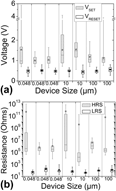Article contents
Development of a silicon oxide-based resistive memory device using a spin-on hydrogen silsesquioxane precursor
Published online by Cambridge University Press: 05 December 2012
Abstract

Resistive memory devices have the potential to replace flash technology due to their increased scalability, low voltage of operation, and compatibility with silicon semiconductor manufacturing. We report a spin-on resistive switching material, hydrogen silsesquioxane (HSQ), which is a commonly used electron beam resist. We demonstrate device scalability from 100 μm to 48 nm and show that the switching properties do not depend on the device size. Set voltages were typically <3 V, while reset voltages were <1 V when analyzing the positive unipolar switching properties of these devices. The ratio of the high resistance to the low resistance was ranged from 101 to 102, creating a distinct memory window between the memory states. Composition–depth profiling revealed that copper from the bottom electrode migrated into the HSQ films as a result of annealing. It is therefore speculated that copper may play a role in the switching properties of devices based on this material.
Information
- Type
- Articles
- Information
- Copyright
- Copyright © Materials Research Society 2012
References
REFERENCES
- 2
- Cited by

